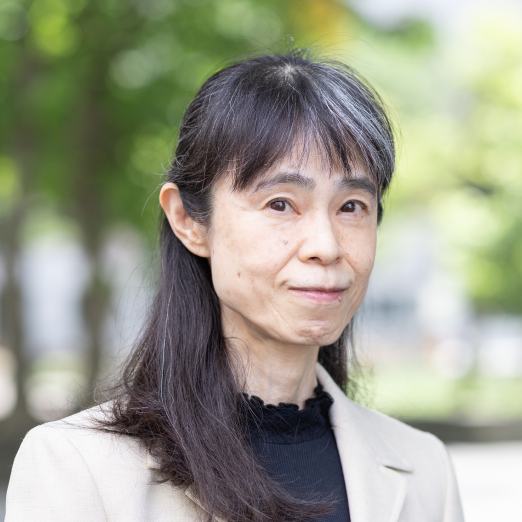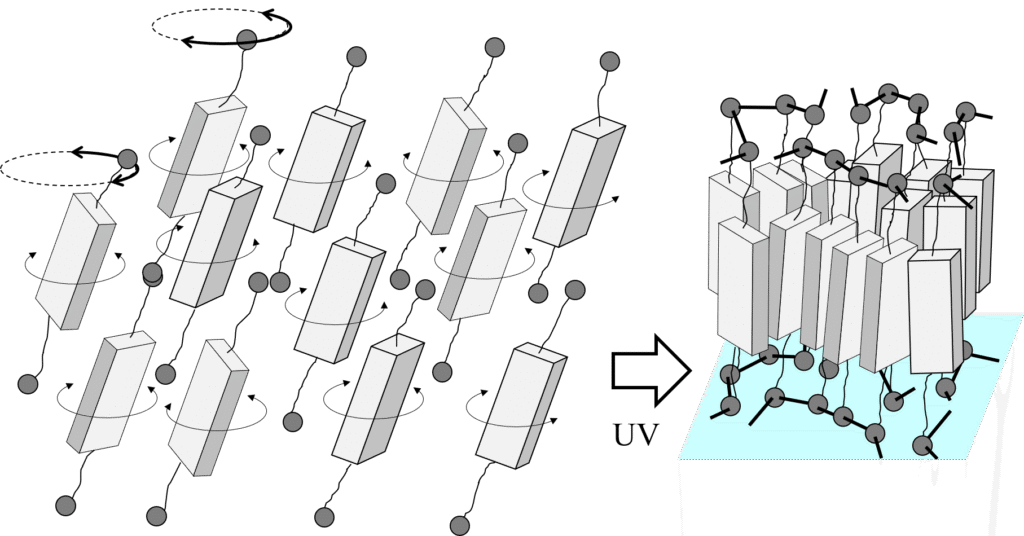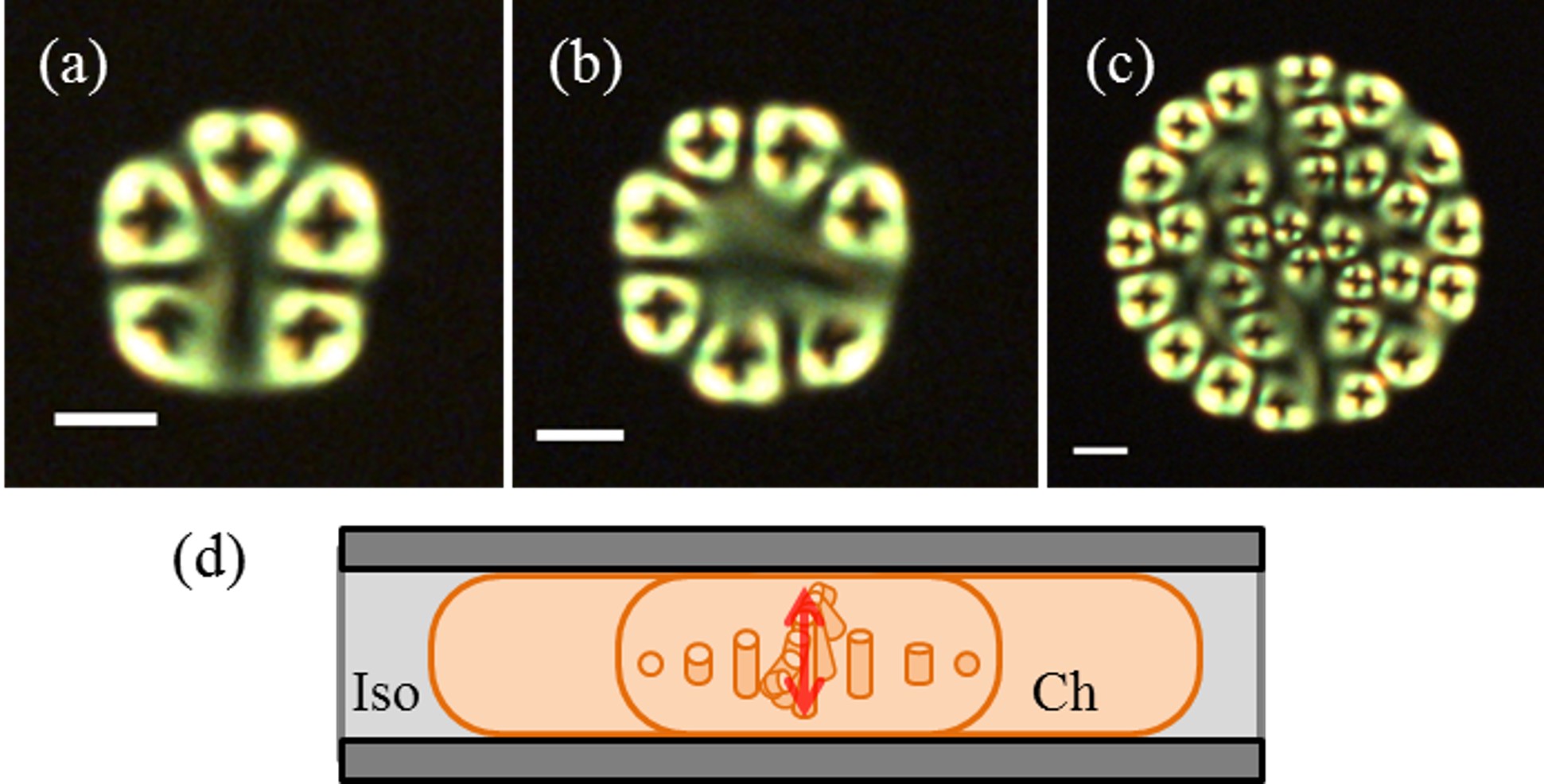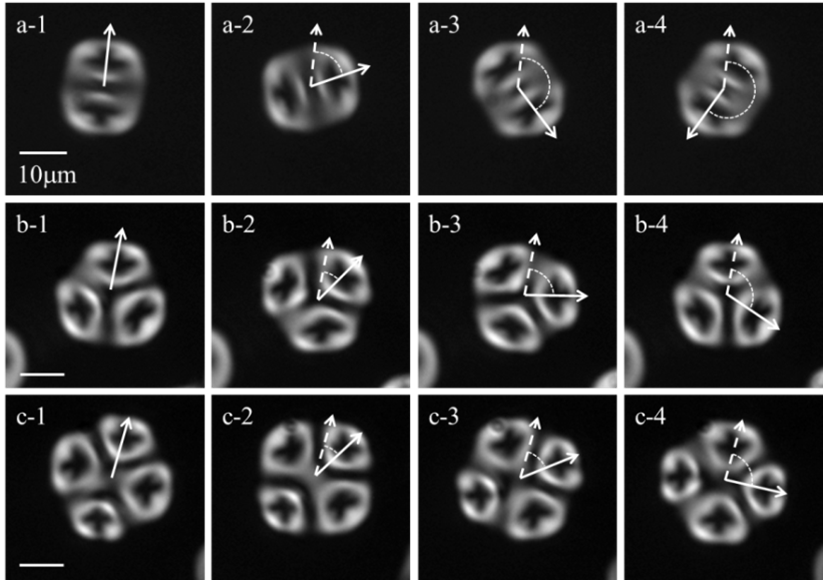
多辺 由佳 教授
Yuka Tabe
専門分野
ソフトマター物理学研究
ソフトマターの動的協調現象
研究テーマ
カイラル液晶の動的交差相関/有機超薄膜の音波物性/混合液晶の動的構造形成
キーワード
液晶,交差相関,対称性の破れ,二次元系,非平衡構造
LINKS
RESEARCH OVERVIEW
研究概要
棒状低分子が分子間力や排除体積効果によって緩やかに結合すると,ネマチックやコレステリックといった液晶相が現れる。液晶分子間にはたらく異方的な相互作用は,分子の向きを揃えるだけでなく,各々の並進・回転運動にも制約を与えている。一般的な液晶デバイスでは熱平衡状態のマクロな構造や性質が利用されるので,自転や振動といった個々の分子の運動は表に出ない。一方,エネルギーや物質の入出流下の非平衡定常状態,特に外場が分子構造や運動を変化させ,それが周囲との相互作用によって選択増幅されて自律構造が現れるような状態では,個々の分子運動とそのマクロ変数への階層縦断的発展過程が構造決定の主役となる。我々はこのような散逸構造に注目し,光異性化で知られるアゾベンゼン液晶の光誘起ダイナミクス,カイラル液晶の線形流(熱流・電流・物質流)による一方向回転,液体薄膜の異常破壊,共存相での界面分子移動による滑り現象などを見出し,次の液晶応用を目指して研究を行ってきた。また,電荷の授受を行う2種のネマチック液晶を混合して得られるスメクチックと呼ばれる相が,静的な構造は単体のスメクチック相と全く同じでありながら粘性だけを増大させることに注目し,速い時間でのみ現れる動的構造と粘性増大のメカニズムを調べている。
「柔らかい分子集合体において,分子のランダムな運動からマクロなダイナミクスに至る,階層を超えた運動の集約はどのように起きるのか」という問いは,学術的な観点からも興味深いが,100億個以上の分子が緩やかな相互作用によって結びつけられた集合体では,入力から出力までが広い時空間スケールにわたるため,これを逐一追跡するのは容易ではない。上記に挙げた具体的な現象を対象に,異なる時空間スケールに対応する各実験を重ねることで,この問いに答える。


MESSAGE to STUDENTS
学生へのメッセージ
液晶ときいて,皆さんは何を思い浮かべるでしょうか。携帯電話,パソコン,テレビなどの表示パネルをはじめ,薬品や化粧品などにも広く使われている他,私達の身体の中にある生体膜もまた液晶の1 種です。一般に液晶を構成する分子は棒のような形をしています。この棒状分子は液晶状態においては自由に動き回りながら,常にその方向を互いにそろえようとします。この柔らかくて強い異方的な分子間相互作用が液晶の特徴であり,表示パネルもこの性質を利用しているといえます。従来の液晶デバイスは,熱平衡状態や平衡状態間の転移を利用したものでした。私達は,外部から一定のエネルギーや物質の出入りがある状態で現れる液晶の散逸構造を利用して,新しいデバイスにつなぎたいと考えています。
学歴・経歴
1987年3月 東京大学工学部物理工学科卒業
1989年3月 東京大学大学院工学系研究科 物理工学専攻修士課程終了
1989年4月 工業技術院 電子技術総合研究所 超分子部 研究官
1996年8月 東京大学大学院より博士(工学)号取得
1996年9月~1998年5月 ハーバード大学物理学科 博士研究員
1998年10月~2001年9月 科学技術振興事業団 さきがけ研究21研究員に併任
2001年4月 独立行政法人産業技術総合研究所ナノテクノロジー研究部門主任研究員
2005年4月~ 早稲田大学理工学術院教授
所属学協会
- 日本物理学会
- 日本液晶学会(2024年度~ 副会長)

Yuka Tabe
Professor
Field of study
Soft Matter Physics
Non-equilibrium dynamics of softly condensed matter
Research Themes
Thremo- and Chemo-mechanical cross correlation / Acoustic properties of organic thin filmes / Dynamical structures of induced smectic phases
Keywords
Liquid Crystals, Cross correlation, Symmetry breaking, Dissipative structures
LINKS
RESEARCH OVERVIEW
Nematic and cholesteric liquid crystal (LC) phases are composed of rod-like molecules, which are loosely packed through intermolecular forces and excluded volume effects. The anisotropic molecular interactions not only align their orientations but also impose constraints on their translational and rotational motions. In general, LC devices make use of the macroscopic structures and properties in their thermal equilibrium states, so that individual molecular motions such as rotation or vibration are hidden. However, in the non-equilibrium steady states, in which energy or mass are consrtantly transferred, the hierarchical evolution from the individual molecular motion to the macroscopic variables plays an essential role in determining apparent structures. Focusing on such dissipative structures, we have investigated various phenomena aimed at future applications of liquid crystals. These include photoinduced dynamics of azobenzene liquid crystals, unidirectional rotation of chiral liquid crystals driven by linear flows (such as heat flux, electric current, or material flow), anomalous rupture of liquid films, and slipping phenomena caused by interfacial molecular migration in coexisting phases. More recently, we have discovered that an induced smectic A phase obtained by mixing two nematic compounds that work as an electron donor and accepter shows extraordinary large viscosity. We are currently exploring the underlying mechanism behind this behavior.
The question, “How do random molecular motions in softly condensed matter develope into macroscopic dynamics across hierarchical levels?” is scientifically intriguing. In assemblies consisting of over ten billion molecules combined by weak and anisotropic interactions, it is difficult to trace the input-output relationships every detail. By conducting a series of experiments tailored to various spatiotemporal scales, we aim to answer this fundamental question.


MESSAGE to STUDENTS
The word of “liquid crystal” probably reminds you of display panels in devices such as smartphones, computers, and televisions. Not only the flat panels, the liquid crystals are also used in pharmaceuticals, cosmetics, and the biological membranes within our bodies. In the liquid crystals statea, the constituting rod-shaped molecules move freely like liquids while constantly trying to align their orientations with one another. This flexible yet strong anisotropic molecular interaction is a defining characteristic of liquid crystals, which is used for display panels.
Traditional liquid crystal devices have relied on the thermal equilibrium states and/or transitions between the equilibrium states. In contrast, we focus on the dissipative structures of liquid crystals that emerge under constant inflow and outflow of energy or matter.
Education and Career
March 1987 Bachelor of Engineering, Applied Physics Department, The University of Tokyo
March 1989 Master of Engineering, Applied Physics Department, The University of Tokyo
September 1996 Doctor of Engineering, Applied Physics Department, The University of Tokyo
April 1989-August 1996 Researcher, Supramolecular Science Division, Electrotechnical Laboratory
September 1996-May 1998 Postdoctoral Fellow, Physics Department,Harvard University
June 1989-March 2001 Senior Researcher, Supramolecular Science Division, Electrotechnical Laboratory
April 2001-March 2005 Senior Researcher, Nanotechnology Research Institute, National Institute of Advanced Industrial Science & Technology (AIST)
April 2005-present Professor, Applied Physics Department, Waseda University
Professional Memberships
- Japanese Physics Society
- Japanese Liquid Crystal Society
